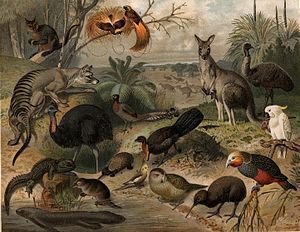Fauna: Difference between revisions
Revert to revision 430610853 dated 2011-05-24 02:03:27 by ClueBot NG using popups |
|||
| Line 14: | Line 14: | ||
[[Image:Australisk fauna, Nordisk familjebok.jpg|thumb|right|300px|[[Australian fauna|Australian]] and [[Fauna of New Zealand|New Zealand Fauna]]. This image was likely first published in the first edition (1876–1899) of the [[Nordisk familjebok]].]] |
[[Image:Australisk fauna, Nordisk familjebok.jpg|thumb|right|300px|[[Australian fauna|Australian]] and [[Fauna of New Zealand|New Zealand Fauna]]. This image was likely first published in the first edition (1876–1899) of the [[Nordisk familjebok]].]] |
||
=== Infauna === |
=== Infauna === |
||
Aquatic animals that live in the substrate of a body of water, especially in a soft sea bottom |
Aquatic animals that live in the substrate of a body of water, especially in a soft sea bottom. |
||
=== Epifauna === |
=== Epifauna === |
||
Revision as of 07:17, 9 June 2011

Fauna or faunæ is all of the animal life of any particular region or time. The corresponding term for plants is flora.
Zoologists and paleontologists use fauna to refer to a typical collection of animals found in a specific time or place, e.g. the "Sonoran Desert fauna" or the "Burgess shale fauna". It also can refer to a given subset of the fauna of a given region, as in: "... the Amazon basin has a rich ant fauna...".
Paleontologists sometimes refer to a sequence of faunal stages, which is a series of rocks all containing similar fossils.
The name comes from Fauna, a Roman fertility and earth goddess, the Roman god Faunus, and the related forest spirits called Fauns. All three words are cognates of the name of the Greek god Pan, and panis is the Greek equivalent of fauna. Fauna is also the word for a book that catalogues the animals in such a manner. The term was first used by Linnaeus in the title of his 1747 work Fauna Suecica.
Subdivisions of fauna

Infauna
Aquatic animals that live in the substrate of a body of water, especially in a soft sea bottom.
Epifauna
Epifauna, also called epibenthos, are aquatic animals that live on the bottom substratum as opposed to within it, that is, the benthic fauna that live on top of the sediment surface at the seafloor.
Macrofauna
Macrofauna are benthic or soil organisms which are retained on a 0.5mm sieve. Studies in the deep sea define macrofauna as animals retained on a 0.3mm sieve to account for the small size of many of the taxa.
Megafauna
Megafauna are large animals of any particular region or time. For example, Australian megafauna.
Meiofauna
Meiofauna are small benthic invertebrates that live in both marine and fresh water environments. The term Meiofauna loosely defines a group of organisms by their size, larger than microfauna but smaller than macrofauna, rather than a taxonomic grouping. One environment for meiofauna is between grains of damp sand (see Mystacocarida).
In practice these are metazoan animals that can pass unharmed through a 0.5 – 1 mm mesh but will be retained by a 30 – 45 μm mesh,[1] but the exact dimensions will vary from researcher to researcher. Whether an organism passes through a 1 mm mesh also depends upon whether it is alive or dead.
Mesofauna
Mesofauna are macroscopic soil invertebrates such as arthropods, earthworms, and nematodes.
Microfauna
Microfauna are microscopic or very small animals (usually including protozoans and very small animals such as rotifers).
Other

Other terms include avifauna, which means "bird fauna" and piscifauna (or ichthyofauna), which means "fish fauna".
Fauna treatises
Classic faunas
- Linnaeus, Carolus. Fauna Suecica. 1746
